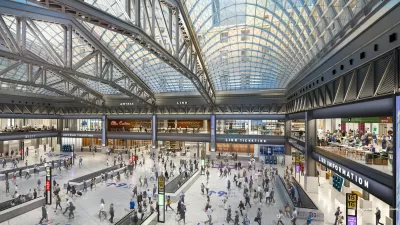CityLab's Eric Jaffe provides an update on the two phases of construction of Moynihan Station, an annex to America's busiest train station. Phase One could be completed next year and Phase Two is in need of a "mere" $200 million. But is that enough?
Moynihan station is the conversion of parts of the adjacent 1912 James A. Farley Post Office, designed by McKim, Mead, and White, which also built the original Penn Station (photo) that was razed in 1963, and the 1919 Hotel Pennsylvania opposite Penn Station on Seventh Ave.
Erik Jaffe of CityLab writes that "Phase One of that project, which should provide better platform access for Amtrak riders, is already underway and may be completed as early as next year. The problem has long been a lack of funding for Phase Two—a grand new train hall filled with retail stores and, if one can believe the renderings, quite a bit more breathing room."
Last week the New York Times reported that Phase Two funding might be closer than previously believed. The Times quotes Senator Charles Schumer, a Moynihan Station proponent, as saying that the city and two developers (Related Companies and Vornado Realty Trust) have pledged $500 million for the great hall, leaving only a $200 million gap. Schumer called on the federal government to make up the difference.
But here's the kicker: According to Michael Kimmelman, architecture critic for The New York Times, the annex helps out only 5 percent of Penn Station's travelers, as he noted here in 2012.
Jaffe points to a column by his colleague, Ben Kabak of 2nd Ave. Sagas, who "reminds us, Moynihan Station would do nothing to address the biggest pressing need for Penn Station: more train capacity under the Hudson River. Unless that shortcoming is addressed, he writes, Moynihan Station will become a 'nicer shell for an older problem'"
Last word to Kabak: "For $1 billion, the Moynihan Station Development Corporation is creating a nicer waiting room for Amtrak without contemplated or expanded train capacity through the station. There's no denying that Penn Station needs fixing...But as dollars for transit are scarce, the priority should be expanding trans-Hudson capacity."
Look for a forthcoming post on just that: "expanding trans-Hudson capacity."
FULL STORY: A New Penn Station Wing for Amtrak in New York May Be Closer Than We Thought

Maui's Vacation Rental Debate Turns Ugly
Verbal attacks, misinformation campaigns and fistfights plague a high-stakes debate to convert thousands of vacation rentals into long-term housing.

Planetizen Federal Action Tracker
A weekly monitor of how Trump’s orders and actions are impacting planners and planning in America.

San Francisco Suspends Traffic Calming Amidst Record Deaths
Citing “a challenging fiscal landscape,” the city will cease the program on the heels of 42 traffic deaths, including 24 pedestrians.

Bend, Oregon Zoning Reforms Prioritize Small-Scale Housing
The city altered its zoning code to allow multi-family housing and eliminated parking mandates citywide.

Amtrak Cutting Jobs, Funding to High-Speed Rail
The agency plans to cut 10 percent of its workforce and has confirmed it will not fund new high-speed rail projects.

LA Denies Basic Services to Unhoused Residents
The city has repeatedly failed to respond to requests for trash pickup at encampment sites, and eliminated a program that provided mobile showers and toilets.
Urban Design for Planners 1: Software Tools
This six-course series explores essential urban design concepts using open source software and equips planners with the tools they need to participate fully in the urban design process.
Planning for Universal Design
Learn the tools for implementing Universal Design in planning regulations.
planning NEXT
Appalachian Highlands Housing Partners
Mpact (founded as Rail~Volution)
City of Camden Redevelopment Agency
City of Astoria
City of Portland
City of Laramie



























